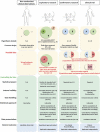Ensuring transparency and minimization of methodologic bias in preclinical pain research: PPRECISE considerations
- PMID: 26683237
- PMCID: PMC4794131
- DOI: 10.1097/j.pain.0000000000000458
Ensuring transparency and minimization of methodologic bias in preclinical pain research: PPRECISE considerations
Abstract
There is growing concern about lack of scientific rigor and transparent reporting across many preclinical fields of biological research. Poor experimental design and lack of transparent reporting can result in conscious or unconscious experimental bias, producing results that are not replicable. The Analgesic, Anesthetic, and Addiction Clinical Trial Translations, Innovations, Opportunities, and Networks (ACTTION) public-private partnership with the U.S. Food and Drug Administration sponsored a consensus meeting of the Preclinical Pain Research Consortium for Investigating Safety and Efficacy (PPRECISE) Working Group. International participants from universities, funding agencies, government agencies, industry, and a patient advocacy organization attended. Reduction of publication bias, increasing the ability of others to faithfully repeat experimental methods, and increased transparency of data reporting were specifically discussed. Parameters deemed essential to increase confidence in the published literature were clear, specific reporting of an a priori hypothesis and definition of primary outcome measure. Power calculations and whether measurement of minimal meaningful effect size to determine these should be a core component of the preclinical research effort provoked considerable discussion, with many but not all agreeing. Greater transparency of reporting should be driven by scientists, journal editors, reviewers, and grant funders. The conduct of high-quality science that is fully reported should not preclude novelty and innovation in preclinical pain research, and indeed, any efforts that curtail such innovation would be misguided. We believe that to achieve the goal of finding effective new treatments for patients with pain, the pain field needs to deal with these challenging issues.
Conflict of interest statement
Sponsorships or competing interests that may be relevant to content are disclosed at the end of this article.
Figures

References
-
- Begley CG, Ellis LM. Drug development: raise standards for preclinical cancer research. Nature 2012;483:531–3. - PubMed
-
- Currie GL, Delaney A, Bennett MI, Dickenson AH, Egan KJ, Vesterinen HM, Sena ES, Macleod MR, Colvin LA, Fallon MT. Animal models of bone cancer pain: systematic review and meta-analyses. PAIN 2013;154:917–26. - PubMed
-
- Dworkin RH, Turk DC, Peirce-Sandner S, Burke LB, Farrar JT, Gilron I, Jensen MP, Katz NP, Raja SN, Rappaport BA, Rowbotham MC, Backonja MM, Baron R, Bellamy N, Bhagwagar Z, Costello A, Cowan P, Fang WC, Hertz S, Jay GW, Junor R, Kerns RD, Kerwin R, Kopecky EA, Lissin D, Malamut R, Markman JD, McDermott MP, Munera C, Porter L, Rauschkolb C, Rice ASC, Sampaio C, Skljarevski V, Sommerville K, Stacey B, Steigerwald I, Tobias J, Trentacosti AM, Wasan AD, Wells GA, Williams J, Witter J, Ziegler D. Considerations for improving assay sensitivity in chronic pain clinical trials: IMMPACT recommendations. PAIN 2012;153:1148–58. - PubMed
Publication types
MeSH terms
Substances
Grants and funding
LinkOut - more resources
Full Text Sources
Other Literature Sources
Medical

